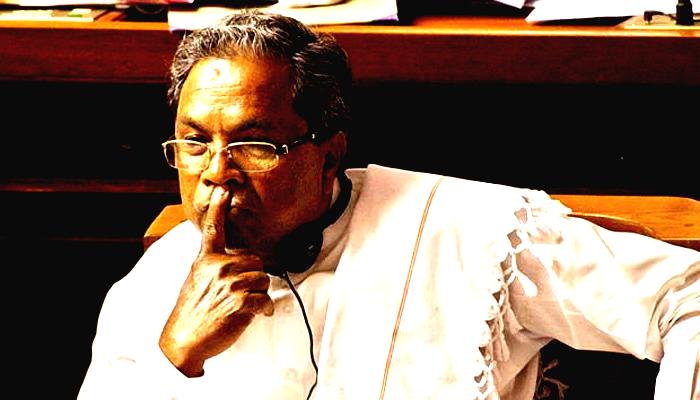It is not uncommon in Indian politics for a government to re-formulate and re-package social welfare schemes announced by the outgoing government, and brand them as their own. This almost always leads to claims and counter-claims. It is also not a rarity for state governments to rebrand the schemes announced by the centre or vice-versa. However, the present Karnataka government and the sitting Chief Minister Siddaramaiah seem to have stooped to a shameful new low. The Congress-led state government has now set a new benchmark in copying schemes by not only rebranding central schemes, but also taking credit for the benefits given under such schemes.
The Siddaramaiah government has rebranded in its own name four such flagship schemes of the Modi government, and has left no stone unturned to hide the Centre’s overwhelming role in the implementation of these schemes. One of these instances is the installation of Wi-Fi facilities under the central scheme ‘Bharat Net’.
The Union Telecommunication Secretary Aruna Sundararajan proposed to provide Wi-Fi in 2,000 villages in Karnataka with the support of the State Government, and in another 2,000 villages using Universal Service Obligation funds (USOFs) which are provided by the Centre. A couple of months later, Chief Minister Siddaramaiah announced that the Karnataka government will provide Wi-Fi access to all gram-panchayats in the state, starting with 2500 gram-panchayats this year. The scheme therefore was nothing but an identical copy of the Central scheme to provide Wi-Fi access to 20,000 villages.
Not only was the scheme copied but Siddaramaiah tried taking credit for the commendable extension of Wi-Fi facilities in gram-panchayats across the state of Karnataka. In fact, as per officials, around 90% of the gram panchayats where the Karnataka government provided Wi-Fi access were already covered by the ‘Bharat Net’ scheme. Therefore, the idea was to take political credit, while the infrastructure was built by the Centre and the execution was also carried out by the Centre. Moreover, Karnataka Chief Minister Siddaramaiah had accidentally admitted this while unveiling the BengaluruITE.biz expo on 28th November 2016. He had said, “We will bank on the national fibre optic network to provide last mile connectivity in all villages, as digital inclusion has become a parameter for growth and economic development.”
’I believe it is essential to bridge the digital divide & provide an opportunity to every entrepreneur from cities and towns across Karnataka, to benefit from the enabling ecosystem’: CM @siddaramaiah at #BlrTechSummit
— CM of Karnataka (@CMofKarnataka) November 16, 2017
Another instance of imitation by the Karnataka Chief Minister Siddaramaiah is the distribution of LED bulbs under the Hosa Belaku Scheme (an unmodified imitation of the Centre run Ujala scheme). The Ujala scheme, one of the flagship schemes announced by the Modi government with the object of providing efficient use of energy at a residential level, had proved to be an instant hit among people across the country. In Karnataka alone, close to 1.95 crore LED bulbs have been distributed till date. However, Chief Minister Siddaramaiah politicised even this noble initiative and delayed the implementation of the scheme almost by a year so, and then brought about the Hosa Belaku scheme for the state. The welfare of the state and residents was forgone for political gains. Siddaramaih as usual is trying to take credit for distribution of LED bulbs, however in reality, Energy Efficiency Services Limited (EESL) which comes under the Union Ministry of Power is executing the Hosa Belaku scheme in Karnataka.
Yet another instance of petty politics by the Siddaramaiah government is the announcement of the Anil Bhagya scheme. The scheme is nothing but a slightly modified and rebranded version of the Centre’s Ujjwala scheme that provides LPG connections to women belonging to Below Poverty Line (BPL) households. The scheme aims at the adverse health effects on women that the use of wood and other domestic fuel cause. It provides a healthier lifestyle to women across the country. In Karnataka, the Centre provided LPG connections to 15,840 BPL households in 2016-17 and 1,18,757 BPL households in 2017-18. However, the Anil Bhagya scheme announced by the government aims at providing LPG connections along with gas stoves. Thus, it is the simple rebranding of the Centre’s initiative with a small and insignificant tweak. However, this scheme which Siddarmaiah has been trying to claim credit for as a radical pro-poor measure, has been a major flop, and only 1.5 lakh connections have been provided as against the target of 16 lakh women.
Another scheme which has been hailed by Chief Minister Siddaramaiah and the Congress as a strong welfare measure and a landmark achievement is the ‘Anna Bhagya’ scheme. However, this scheme is nothing but an attempt at distributing food grains under the PDS under a different name. In fact, in reply to an RTI, it was admitted that the Centre bears an overwhelming part of the total cost entailed in the procurement and distribution of the food grains under the scheme. While the Central government bears Rs. 29 for one kilo of rice, the state government has to bear merely Rs. 3.
RTI revealed the truth of #AnnaBhagya.
Central Govt bears Rs.29 and Karnataka state govt only Rs.3 per kilogram of rice.Thank you @narendramodi government for Anna Bhagya help! @KiranKS pic.twitter.com/mmUfq2lNq3
— Vivek Shetty (@vivekshettym) November 23, 2017
It can thus be safely concluded that most of the claims Siddaramaiah and the Congress have made in the run up to the assembly polls are political gimmicks. Most of the schemes that have been implemented in Karnataka in the last five years have been directly provided by the Centre. And even where the State had a role to play, the infrastructure as well as the major distribution costs were borne by the Centre.
